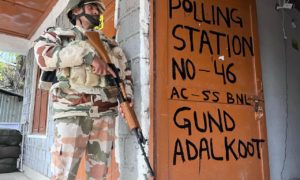The militia is an irregular mix of mountaineers, boxers, members of local fight clubs
New Delhi: China has mobilised thousands of soldiers, tanks and howitzers within rifle range of Indian Army deployment at Spanggur Gap in the southern part of Pangong Tso in eastern Ladakh, sources said, even as Indian troops are on high alert.
“Seeing the Chinese PLA troop and guns mobilisation, the Indian Army too made mirror deployments at Spanggur Gap. Both the countries’ troops and guns are within shooting range,” said a government official.
Further, sources said, China has deployed its militia squads to “consolidate the border” and “stabilise Tibet region”.
They have been tasked to try and dislodge the Indian Army soldiers from the tactical heights.
The militia is an irregular mix of mountaineers, boxers, members of local fight clubs and others. Most of the members are raised from the local population.
“Militia is basically a reserve force of the Chinese’s People Liberation Army. They are deployed during war time situations and to help the PLA in its military operations,” said a senior government officer.
The officer also said that Chinese militia also conducts independent operations and provides combat support and manpower replenishment to the PLA.
Movement of Chinese troops, vehicles and new defence mechanisms of Chinese are visible in the north, south banks of Pangong Lake. In some places heavily armed troops are in close proximity.
To de-escalate the situation, armies of India and China are holding interactions daily.
ALSO READ: Amid ‘disengagement’ claims meetings between India-China yield no results
Meanwhile, the People’s Liberation Army heavily deployed its troops along the Line of Actual Control in Ladakh’s Chushul district, which was followed by Indian Army changing its positions from “border management” to “border securing,” a Hindustan Times report read.
China has been deploying fighter and bomber aircraft to its bases in Tibet ever since tension over Ladakh started rising in May, The Week reported.
Earlier, China demanded that India withdraw its armed forces personnel from China-India border in order to avoid escalation of tensions.
China has reportedly built surface-to-air missiles near a lake, which is a part of the Kailash-Mansarovar.
On August, 31, Indian army informed that Chinese troops “carried out provocative military movements to change the status quo” near Pangong Tso lake in Ladakh, and they were blocked by the Indian armed forces personnel manning the area, the government said.
A Brigade Commander level Flag Meeting was later held at Chushul to resolve the issues, as per the Government of India situation update.
As New Delhi claims that both India and China will “continue to sincerely work towards complete disengagement” of armed forces personnel, talks aimed at resolving the military standoff along the Line of Actual Control (LAC) in Ladakh, has so far yielded no results.
A Chinese diplomat reacting to the standoff in Ladakh had said that the move is linked to the Indian government’s unilateral decision to scrap Article 370 in August last year.
The move changed the laws that prohibited Indians from buying land in Kashmir, and made the constitution of Jammu and Kashmir defunct, triggering fears of demographic change in the Muslim majority region of Kashmir.
When India scrapped Jammu and Kashmir’s special status on August 5 last year, the Chinese foreign ministry had issued two statements criticising the development, including one that focused on the splitting of the state into union territories.
This statement, while urging India to be “cautious” on the border issue and to avoid “actions that further complicate the border issue”, said: “China has always opposed India’s inclusion of Chinese territory in India’s administrative jurisdiction in the western part of the Sino-Indian border.”
This was a reference to the area in Ladakh that New Delhi claims but is controlled by Beijing.
Free Press Kashmir is now on Telegram. Click here to Join.








